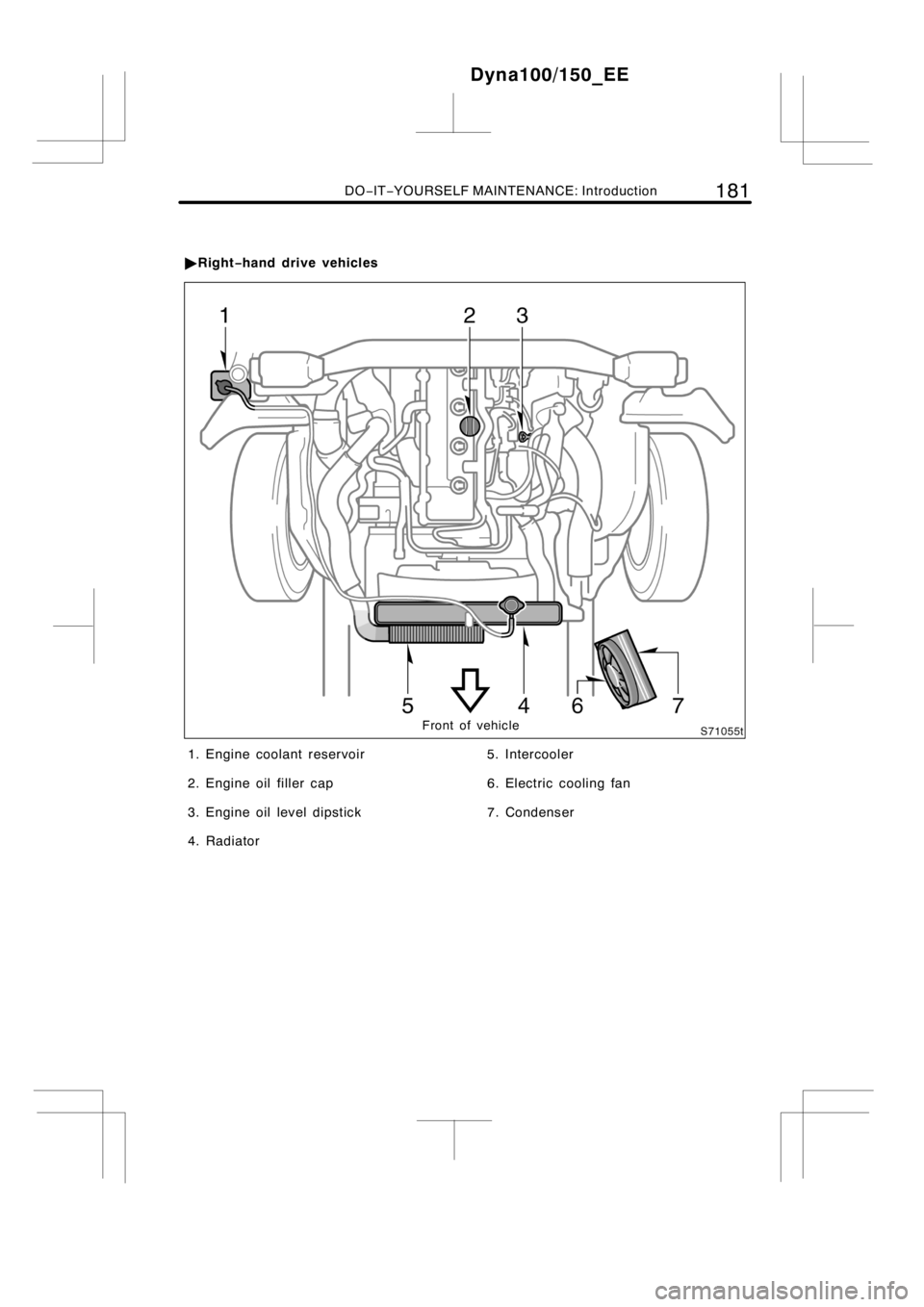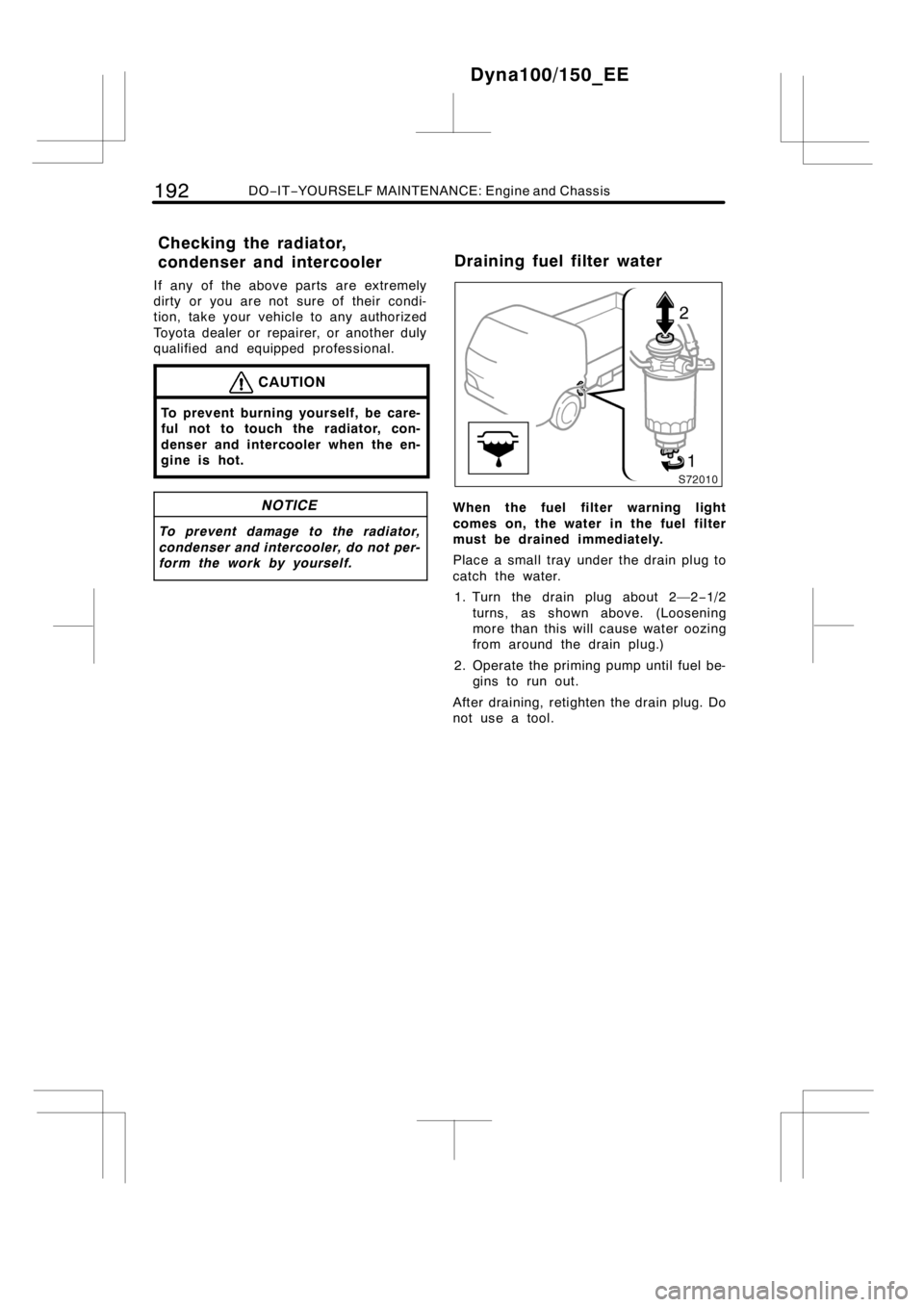radiator TOYOTA DYNA 100/150 2014 Owners Manual (in English)
[x] Cancel search | Manufacturer: TOYOTA, Model Year: 2014, Model line: DYNA 100/150, Model: TOYOTA DYNA 100/150 2014Pages: 232, PDF Size: 14.97 MB
Page 154 of 232

148IN CASE OF AN EMERGENCY
If your engine coolant temperature
gauge indicates overheating, if you ex-
perience a loss of power, or if you hear
a loud knocking or pinging noise, the
engine has probably overheated. You
should follow this procedure...
1. Pull safely off the road, stop the ve-
hicle, and turn on your emergency
flashers. Put the transmission in neu-
tral and apply the parking brake. Turn
off the air conditioning if it is being
used.
2. If coolant or steam is boiling out of the
radiator or reservoir, stop the engine.
Wait until the steam subsides before
opening the engine access hole cover
or tilting the cab. If there is no coolant
or steam boiling over, leave the engine
running and make sure the electric
cooling fan is operating. If it is not,
turn the engine switch off.
CAUTION
To help avoid serious injury, keep the
engine access hole cover closed or
the cab lowered until there is no
steam. Escaping steam or coolant is
a sign of very high pressure.
3. Visually check to see if the engine
drive belt (fan belt) is broken or loose.
Look for obvious coolant leaks from the
radiator, hoses, and under the vehicle.
However, note that water draining from
the air conditioning is normal if it has
been used.
CAUTION
When the engine is running, keep
hands and clothing away from the
moving fan and engine drive belts.
4. If the engine drive belt is broken or the
coolant is leaking, stop the engine im-
mediately. Call any authorized Toyota
dealer or repairer, or another duly qual-
ified and equipped professional, for as-
sistance.
5. If the engine drive belt is O.K. and
there are no obvious leaks, you may
help the engine cool down more quickly
by running it at about 1500 rpm for a
few minutes with the accelerator pedal
lightly depressed.
6. Check the coolant reservoir. If it is dry,
add coolant to the reservoir while the
engine is running. Fill it about half full.
For the coolant type, see “Coolant type
selection” on page 191 in Section 7−2.
CAUTION
Do not attempt to remove the radiator
cap when the engine and radiator are
hot. Serious injury could result from
scalding hot fluid and steam blown
out under pressure.
7. After the engine coolant temperature
has cooled to normal, again check the
coolant level in the reservoir. If neces-
sary, bring it up to half full again.
Serious coolant loss indicates a leak in
the system. You should have it
checked as soon as possible at any
authorized Toyota dealer or repairer, or
another duly qualified and equipped
professional.
Dyna100/150_EE
If your vehicle overheats
Page 186 of 232

180DO−IT−YOURSELF MAINTENANCE: Introduction
Front of vehicle
1. Engine coolant reservoir
2. Engine oil filler cap
3. Engine oil level dipstick
4. Radiator5. Intercooler
6. Electric cooling fan
7. Condenser
Dyna100/150_EE
Engine compartment overview
"Left−hand drive vehicles
Page 187 of 232

DO−IT−YOURSELF MAINTENANCE: Introduction181
Front of vehicle
1. Engine coolant reservoir
2. Engine oil filler cap
3. Engine oil level dipstick
4. Radiator5. Intercooler
6. Electric cooling fan
7. Condenser
Dyna100/150_EE
"Right−hand drive vehicles
Page 191 of 232

DO−IT−YOURSELF MAINTENANCE: Introduction185
If you perform maintenance by yourself,
be sure to follow the correct procedure
given in this Section.
You should be aware that improper or in-
complete servicing may result in operating
problems.
This Section gives instructions only for
those items that are relatively easy for an
owner to perform. As explained in Section
6, there are still a number of items that
must be done by a qualified technician
with special tools.
Utmost care should be taken when work-
ing on your vehicle to prevent accidental
injury. Here are a few precautions that
you should be especially careful to ob-
serve:
CAUTION
DWhen the engine is running, keep
hands, clothing, and tools away
from the moving fan and engine
drive belts. (Removing rings,
watches, and ties is advisable.)
DRight after driving, the engine
compartment—the engine, radiator,
exhaust manifold and power steer-
ing fluid reservoir, etc.—will be hot.
So be careful not to touch them.
Oil and fluids may also be hot.
DIf the engine is hot, do not remove
the radiator cap or loosen the drain
plugs to prevent burning yourself.
DDo not leave anything that may
burn easily, such as paper or rags,
in the engine compartment.
DDo not smoke, cause sparks or al-
low open flames around fuel or the
battery. Their fumes are flammable.
DBe extremely cautious when work-
ing on the battery. It contains poi-
sonous and corrosive sulfuric acid.
DDo not get under your vehicle with
just the body jack supporting it. Al-
ways use automotive jack stands or
other solid supports.
DBe sure that the engine switch is
off if you work near the electric
cooling fans. With the engine
switch on, the electric cooling fans
will automatically start to run if the
engine coolant temperature is high
and/or the air conditioning is on.
DUse eye protection whenever you
work on or under your vehicle
where you may be exposed to flying
or falling material, fluid spray, etc.
DUsed engine oil contains potentially
harmful contaminants which may
cause skin disorders such as in-
flammation or skin cancer, so care
should be taken to avoid prolonged
and repeated contact with it. To re-
move used engine oil from your
skin, wash thoroughly with soap
and water.
DDo not leave used oil within the
reach of children.
DDispose of used oil and filter only
in a safe and acceptable manner.
Do not dispose of used oil and fil-
ter in household trash, in sewers or
onto the ground. Call your dealer or
a service station for information
concerning recycling or disposal.
DTake care when filling the brake and
clutch fluid reservoirs because
brake fluid can harm your hands or
eyes. If fluid gets on your hands or
in your eyes, flush the affected area
with clean water immediately. If you
still feel uncomfortable with your
hands or eyes, go to the doctor.
Dyna100/150_EE
Do−it−yourself service
precautions
Page 192 of 232

186DO−IT−YOURSELF MAINTENANCE: Introduction
NOTICE
zRemember that battery cables carry
high currents. Be careful of acci-
dentally causing a short circuit.
zAdd only “Toyota Super Long Life
Coolant” or similar high quality eth-
ylene glycol based non−silicate,
non−amine, non−nitrite, and non−bo-
rate coolant with long−life hybrid
organic acid technology to fill the
radiator. “Toyota Super Long Life
Coolant” is a mixture of 50% cool-
ant and 50% deionized water.
zIf you spill some of the coolant, be
sure to wash it off with water to
prevent it from damaging the parts
or paint.
zDo not overfill power steering fluid,
or the power steering could be
damaged.
zIf you spill brake fluid, be sure to
wash it off with water to prevent it
from damaging the parts or paint.
zDo not drive with the air cleaner
filter removed, or excessive engine
wear could result.
zBe careful not to scratch the glass
surface with the wiper frame.
zWhen closing the engine access
hole cover or lowering the cab,
check to see that you have not for-
gotten any tools, rags, etc.
Dyna100/150_EE
Page 193 of 232

DO−IT−YOURSELF MAINTENANCE: Engine and Chassis187
Section 7−2
DO−IT−YOURSELF MAINTENANCE
Engine and Chassis
DChecking the engine oil level 188........................
DChecking the engine coolant level 190...................
DChecking the radiator, condenser and intercooler 192.....
DDraining fuel filter water 192............................
DChecking tire inflation pressure 193.....................
DChecking and replacing tires 194........................
DRotating tires 195......................................
DInstalling snow tires and chains 196.....................
DReplacing wheels 197..................................
Dyna100/150_EE
Page 196 of 232

190DO−IT−YOURSELF MAINTENANCE: Engine and Chassis
To ensure excellent lubrication perfor-
mance for your engine, Toyota recom-
mends the use of “Toyota Genuine Motor
Oil”, which has been specifically tested
and approved for all Toyota engines.
Please contact any authorized Toyota
dealer or repairer for further details about
“Toyota Genuine Motor Oil”. Other motor
oils of matching quality also be used.Look at the see−through coolant reser-
voir when the engine is cold. The cool-
ant level is satisfactory if it is between
the “FULL” and “LOW” lines on the
reservoir. If the level is low, add the
coolant. (For the coolant type, see
“Coolant type selection” described be-
low.)
The coolant level in the reservoir will vary
with engine temperature. However, if the
level is on or below the “LOW” line, add
coolant. Bring the level up to the “FULL”
line.
If the coolant level drops within a short
time after replenishing, there may be a
leak in the system. Visually check the
radiator, hoses, radiator cap and drain
cock and water pump.
If you can find no leak, have any autho-
rized Toyota dealer or repairer, or another
duly qualified and equipped professional,
test the cap pressure and check for leaks
in the cooling system.
CAUTION
To prevent burning yourself, do not
remove the radiator cap when the en-
gine is hot.
Dyna100/150_EE
Checking the engine coolant
level
Page 198 of 232

192DO−IT−YOURSELF MAINTENANCE: Engine and Chassis
If any of the above parts are extremely
dirty or you are not sure of their condi-
tion, take your vehicle to any authorized
Toyota dealer or repairer, or another duly
qualified and equipped professional.
CAUTION
To prevent burning yourself, be care-
ful not to touch the radiator, con-
denser and intercooler when the en-
gine is hot.
NOTICE
To prevent damage to the radiator,
condenser and intercooler, do not per-
formtheworkbyyourself.
When the fuel filter warning light
comes on, the water in the fuel filter
must be drained immediately.
Place a small tray under the drain plug to
catch the water.
1. Turn the drain plug about 2—2−1/2
turns, as shown above. (Loosening
more than this will cause water oozing
from around the drain plug.)
2. Operate the priming pump until fuel be-
gins to run out.
After draining, retighten the drain plug. Do
not use a tool.
Dyna100/150_EE
Checking the radiator,
condenser and intercoolerDraining fuel filter water
Page 228 of 232

222INDEX
A
Adding washer fluid 204..................
Adjustment
Driver ’s seat 25.......................
Seat belt 28...........................
Air bleeding 142.........................
Air conditioning filter 93..................
Air conditioningsystem 84...............
Airbag 38...............................
Anti−lock brake system
warning light 73.......................
Anti−theft steering column lock 80........
Appearance care
Cleaning the interior 173...............
Protecting your Toyota from
corrosion 170.......................
Washing and waxing 171...............
Auxiliary box 102........................
B
Battery
Access 182...........................
Checking battery condition 200.........
Gas caution 200.......................
Handling safety 200...................
Recharging precautions 202............
Winter driving tips 129.................
Before starting the engine 124............
Brake pad wear indicators 119............
Brake system 116.......................
Brake system warning light 73............
Brakes
Pad wear indicators 119................
Parking 82............................
Break−in tips 108........................
C
Carbon monoxide caution 114............
Card holder 104.........................
Center console box 103..................
Charging system warning light 73.........
Checking and replacing fuses 203........
Checking the engine oil level 188.........
Checking the radiator, condenser and
intercooler 192........................Child restraint
Child restraint system 45...............
Installation 48,51......................
Precautions 44........................
Types of child restraint system 46.......
Cigarette lighter and ashtrays 100........
Cleaning the interior 173.................
Cold weather
Operation 129.........................
Condenser
Checking the condenser 192...........
Controls, Instrument panel 2,6...........
Cooling system
Coolant level 190......................
Engine overheating 148................
Radiator and reservoir 190.............
Radiator cap 148......................
Winter driving tips 129.................
Corrosion prevention 170................
Cup holder 102..........................
D
Diesel particulate filter system 110........
Differential, Limited slip 120..............
Dimmer switch, Headlight 62.............
Directional signals 62....................
Do−it−yourself maintenance
Service precautions 185...............
Does your vehicle need repairing? 177....
Doors
Side doors 13.........................
DPF system 110.........................
Driver ’s seat 25.........................
Driving
Driving tips 124........................
Manual transmission 81................
Driving in the rain 128....................
Driving tips
Driving in the rain 128..................
Driving tips in various conditions 127....
Driving with a manual
transmission 81.....................
Economical driving 138................
Good driving practice 81...............
Pre−trip safety check 126..............
Winter driving tips 129.................
During
Break−in 108..........................
Dyna100/150_EE
Page 231 of 232

INDEX225
N
New vehicle break−in 108................
O
Odometer 70............................
Oil
Consumption 115......................
Oil maintenance management
system 70..........................
Viscosity and grade 188................
Oil consumption 115.....................
OMMS 70...............................
Operation in foreign countries 110........
Overheating, Engine 148.................
Overheating, Engine coolant 68..........
Overview
Engine compartment 180...............
P
Parking brake
Operation 82..........................
Reminder light 82.....................
Parking brake reminder light 73...........
Polishing 171...........................
Power window switches 14...............
Pre−trip safety check 126................
Precautions for turning off an engine
with turbocharger 126..................
Preloader (seat belt pretensioner) 35.....
Pretensioner
(seat belt pretensioner) 35.............
Protecting your Toyota from
corrosion 170.........................
R
Radiator
Checking the radiator 192..............
Coolant, Engine 190...................
Rear fog light switch 64..................
Rear heatersystem 92...................
Rear seat 26............................
Rear view mirrors
Folding 59............................
Outside 59............................
S
Safety check, Pre−trip 126...............
Seat belts
Cleaning 173..........................
Fastening 28..........................
Seat belt precautions 28...............
Seat belt pretensioner 35..............
Seats 24................................
Service and maintenance 176............
Service reminder indicator 73............
Side door locks 13.......................
Side doors 13...........................
Side gate 16............................
Side vents 91...........................
Spare fuse 203..........................
Spare tire 150...........................
Specifications 212.......................
SRS driver airbag 38....................
SRS warning light 73....................
Starting
Cold weather 124......................
Engine 124............................
Jump starting 143.....................
Steering
Adjusting steering wheel 58............
Storage precautions 101.................
Suspension and chassis 122.............
Switch
Emergency flasher 64.................
Engine 80.............................
Headlight, dimmer and
turn signal 62.......................
Heater idle up 93......................
Ignition 80............................
Rear fog light 64.......................
Windshield wiper and washer 65........
T
Tachometer 69..........................
Tailgate 16..............................
Telescopic steering wheel 58.............
Tilt cab 18..............................
Tilt steering wheel 58....................
Timing belt replacement
warning light 73.......................
Dyna100/150_EE